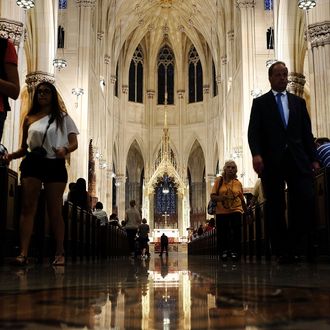
In the glory years of Europe’s Gothic cathedrals, it took just one structure in each archbishopric to elevate artisanship into art. Stonemasons, sculptors, carpenters, glazers, weavers, blacksmiths, painters — armies of craftsmen swarmed over construction sites that remained incomplete for generations. You might think that those skills would have withered in our era of 3-D printing and robot-assisted manufacture. The word artisanal has become a punch line, an all-purpose modifier for pickles and chocolate that resist industrialization.
But take one look at the rejuvenated St. Patrick’s Cathedral and you realize that the world still contains non-ironic specialists with infinite patience and dexterous fingers. The original construction lasted 20 years from cornerstone to the dedication in 1878 — a mayfly’s lifespan in cathedral-building terms. The current restoration took another nine. More than 150 workers, directed by the architecture firm Murphy Burnham & Buttrick, made 30,000 separate interventions, planned and tracked with advanced software but executed by hand. Workers filled the interior with a city of scaffolding. Specialists climbed it to heal cracks in stained glass, fix shattered bits of tracery with invisible puzzle pieces of steel, scour soot off blackened marble, rebuild eroded filigree, replace crumbling stones, replaster ribbed vaults, and revivify wooden screens.
The result is so conspicuously glorious that it makes Rockefeller Center look suddenly shabby by comparison. When Pope Francis steps into the high, cream-colored nave on September 24 to lead Vespers, he will see a building overhauled by hand and eye, a monument to fine-grained labor. St. Patrick’s was built as a testament to the growing Catholic presence in New York and paid for by tycoons and day laborers. (The archdiocese is keeping to itself the sources of the $177 million it raised to refurbish the cathedral.) But even shining monuments to timeless faith get scraggly over the years. Before the restoration, sunlight struggled through darkened windows and got sucked into gray-green vaults. Now the stained glass glows, and the ceiling, restored to its original patterns of pale ocher on plaster, painted to resemble stone, spreads light on the nave below. It helps, too, that the immense bronze doors now remain open in all but the most brutal weather, welcoming in visitors and sunshine.
All this can come as a bit of a shock. An old building that’s been made as good as new can also look inauthentic. In Chartres, France, the ongoing efforts to lighten the medieval cathedral’s ancestral gloom so alarmed the critic Martin Filler that he called it a “scandalous desecration of a cultural holy place.” But restorers in Chartres are bringing back the newborn brightness of 800 years ago, which quickly faded and was never seen again. By contrast, the architect Jeffrey Murphy described the St. Patrick’s project as a conservation job — cleaning and repairing what was there, without trying to roll back history. The most impressive tasks aren’t even visible: replacing the entire cooling and heating system and hooking them up to geothermal wells that have been sunk up to 2,200 feet below Manhattan’s asphalt crust.
Among this project’s clutch of religious symbols and pastoral meanings, one message jumps out to a lay observer: When architecture and workmanship can be this good, there is little excuse to settle for less, especially in midtown Manhattan. Today’s builders of deluxe towers often justify glass boxes, prefabricated modules, and cracked concrete floors with the complaint that it’s too expensive or impractical to revive the craftsmanship of yore. Where are you going to find the Sicilian stone-worker families of a century ago? So much more efficient to order curtain walls from China. Large-scale restoration projects like this one give the lie to that self-serving shrug. If artisans can make old stone buildings look young again, surely some can apply their skills to new designs and provide the city some new grain, some textured alternative to the grim uniformity of gloss.






























